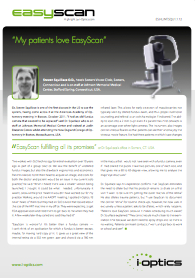“My patients love EasyScan”
Steven Squillace O.D., heads Somers Vision Clinic, Somers, Connecticut and is on staff at Johnson Memorial Medical Center, Stafford Spring, Connecticut, USA. Dr. Steven Squillace is one of the first doctors in the US to use the system, having come across it at the American Academy of Optometry meeting in Boston, October 2011. “I had an old fundus camera that needed to be replaced” said Dr. Squillace who is on staff at Johnson Memorial Medical Center and trained at Joslin Diabetes Center whilst attending the New England College of Optometry in Boston, Massachusetts, USA.
“I’ve worked with SLO technology for retinal evaluation over 10 years ago as part of a group practice. We saw the benefit of undilated fundus images, but also the drawback: ergonomics and economics. Patients needed to tilt their head to acquire an image, and costs for both the doctor and patient would be an issue in my current solo practice,” he said. “When I heard there was a smaller version being launched, I thought it could be what I needed. Unfortunately it wasn’t, because the price meant it wouldn’t have worked out for my practice. Walking around the AAOPT meeting, I spotted i-Optics. I’d never heard of them but they had an SLO device that looked about the size of the HRT machine in my office. They were expecting to get FDA approval soon and I told them to get back to me when they had it. A few weeks later they called and said they had it!”
“EasyScan is wonderful. It’s better than a fundus camera — I can’t think of an application for which a fundus is better except, maybe, for making hard copy print. It gives us a great view of the internal retina via a 532 nm green laser and choroid via a 780 nm infrared laser. This allows for early detection of maculopathies not typically seen by dilated fundus exam, and thus proper nutritional counseling and referral to an ophthalmologist if indicated. The ability to scan into a 2 mm pupil even if a patient has mild cataracts is an advantage over white light cameras. The instrument also images central vitreous floaters so that patients can see their anomaly by the vitreous movie feature. I’ve had three patients in which I saw changes in the macula that I would not have seen with a fundus camera, even if I had dilated the pupils. I take two pictures, one of each side, and that gives me a 60 to 65-degree view, allowing me to analyse the major eye structures.”
Dr. Squillace says his experience confirms that EasyScan eliminates the need to dilate but that his protocol remains to dilate on a first visit: “I want to be sure I’m getting the outer reaches of the retina.” He also dilates trauma patients, but “I use EasyScan to document the central retina.” For routine check-ups, however, he now uses it exclusively unless a patient asks to be dilated, which rarely happens. “Patients love EasyScan because it makes scheduling much easier,” Dr. Squillace explained. “They can schedule much closer to the examination time because we don’t need to apply drops and so there is no waiting. Patients can insert contacts, if worn, and go back to work or school and see!”

